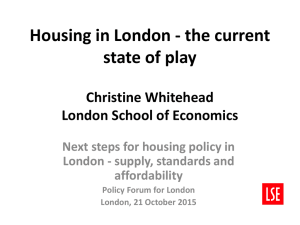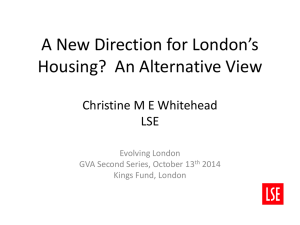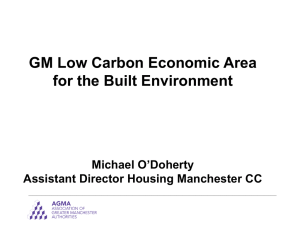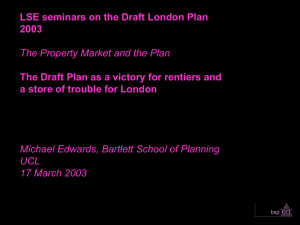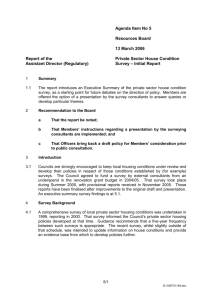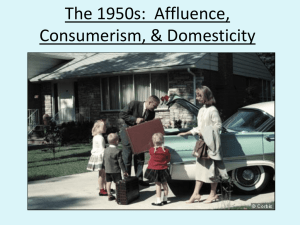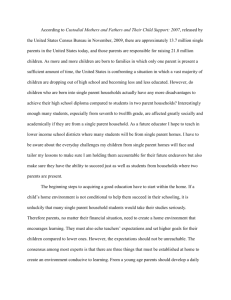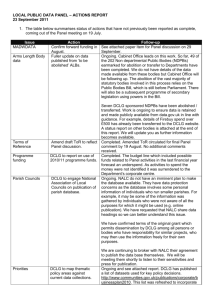Progress and priorities for housing in the capital
advertisement
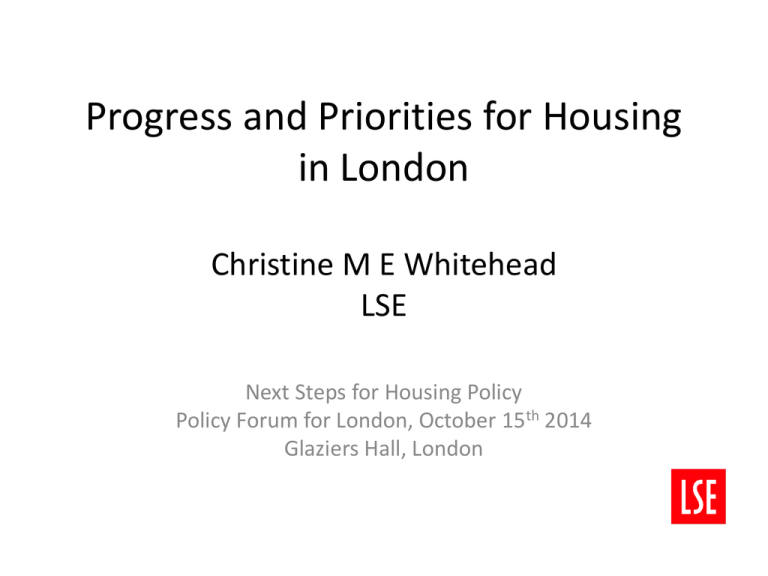
Progress and Priorities for Housing in London Christine M E Whitehead LSE Next Steps for Housing Policy Policy Forum for London, October 15th 2014 Glaziers Hall, London Progress The Negatives: the Positives • • • • • • • • • Completions still falling Densities and overcrowding increasing Homelessness rising – 80% higher than in 2010 House prices and new let rents rising BUT Planning permissions and now starts rising quite rapidly Increasing emphasis on unlocking large sites with assistance from GLA/HCA and DCLG – Housing Zones Increasing interest from Housing Associations and institutional funding in PRS Attempts to improve rental offer Large number of government incentives Hope over Experience or a New World? What are the big issues? • Shorter term problem arising from the financial crisis and the subsequent near closure of the mortgage and development funding markets • Longer term problem about the slow and inadequate response of new supply to changing demand • The concentration of demand in London • House price volatility and macro economic instability • Worsening access to housing of all types • Structural changes in tenure • Reductions in government support for both supply and demand - which are unlikely to be reversed whatever the result of the election • Current plans need a reality check How big is London’s housing problem? • Updated projections suggests 53,000 homes a year required • This still implies falling headship rates for 25-34s. • ‘No age group worse off’: 63,000 homes a year. • Alan Holmans: 23,000 affordable homes a year • 15 boroughs housing a third more households in over 20 years? • London’s housing shortfall could be around 30,000 homes a year What has been happening? • Many fewer younger households • Many fewer single person households • More ‘others’ • More couples – with and without children. What might happen 2011 to 2021? 2011-21 - from DCLG 2011 Homes needed or released New 15-24 124000 15-24 to 25-34 535000 25-34 to 35-44 285000 35-44 to 45-54 -6000 45-54 to 55-65 -52000 55-64 to 65-74 -91000 65-74 to 75-84 -56000 75-84+&over to 85&over -199000 • Cohort requirements from DCLG’s 2011-based projection (based on 53,000 pa) • 149,000 homes released by households aged 35-74, many from moves out of London – but will there be somewhere for them to go? • Biggest impact of undersupply likely to be on groups with biggest net requirement Priorities • Is it just new build, new build and new build? • But building more will not have much immediate effect on prices; • The recession has reduced household formation – so any economic improvement is likely to offset demographic changes putting further pressure on the market; • The demand for housing rises not just with demographics but as much because of income growth – so economic success means higher demand; • So there is an inherent tension between success in the London economy and success in providing housing for Londoners; • The easiest and worst way of reducing demand and house prices in current conditions is to have a recession. This is NOT what anyone wants; • So have to accept indicators will get worse BUT not a reason not to try. Concerns about what and where we going to build? • • • • • • Plan assumes (has to assume?): - building within the GLA boundary - building high and high/super density - building for the private rented sector - continuing to build significant proportions of social and affordable housing; But very different development model from before the crisis and many reasons (including experience) to expect the process to be much slower than predicted; And scale and location issues: - Opportunity and especially housing zones - Garden cities and/or cities within cities? - Change of use from commercial Greenbelt/greenfield? All must be tried, but all have major issues (including the potential for building the slums of the future) Still massive political objections to development, especially in outer suburbs where need to raise densities A More Fundamental Priority: Housing, Welfare and Affordability • Who can afford to live in London? • Camden evidence that only 14% of those in the private rented sector (33% of the housing stock) are in receipt of Housing Benefit – the poor have already left? • Majority of new claimants working and often on incomes well above the median - implying both very high marginal tax rates for tenants and no direct incentive to keep rents down; • Universal Credit may even worsen the situation; • Alternatives to the welfare bill – owner-occupation; a better form of intermediate housing; grants for social housing? Conclusions • If London is to remain a world city the housing problems will not go away – indeed will probably worsen; • Those who are prepared to pay more and live in worse conditions will outbid those who can make other choices; • Need to do all that is possible to build – but new initiatives take longer to get going; • Can more be done in more traditional ways – especially in the outer suburbs; • The current model of revenue subsidies cannot be sustained • Need intermediate tenures – including shared equity - to play a larger role; • Need to improve outward mobility; • Need to tax established households more effectively; • Need commitment and stability in both policy and the macroeconomy!
